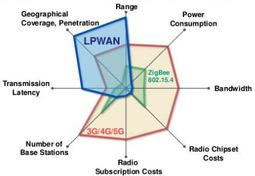Zeta Wireless Technology Explained: Features and Advantages
Advertisement
This page covers the basic features of Zeta wireless LPWAN (Low Power Wide Area Network) technology.
It also outlines the benefits and advantages of Zeta technology.
Introduction
Zeta is a global LPWAN technology designed for low-cost, long-range IoT device connections. The standard and certification are managed by the Zeta Alliance.
This alliance boasts over 300 member companies, primarily located in Japan and China, including KDDI research, Toray Advanced materials, Toppan NTT Data Co. Ltd., Techsor, OYO, and Sky Technology.
Zeta supports bi-directional communication between Zeta devices and multi-hop communication with self-healing capabilities. It’s capable of monitoring mobile objects at speeds up to 120 Km/h. The technology utilizes the ZETA-P protocol, which allows data transmissions of up to 50 bytes. The ZETA-S protocol, on the other hand, supports two-way communication for over 90,000 devices and supports remote OTA (Over-the-Air) updates.

Image Courtesy: zifisense.com
The figure above illustrates the Zeta network architecture, which consists of Zeta AP (Access Point), Zeta server, Zeta Mote, and Zeta sensors. Cloud connectivity is provided through cloud servers as shown.
Features of Zeta
| Feature | Specification |
|---|---|
| Operating frequency | Sub 1 GHz frequency bands which include 433 MHz, 470 MHz, 500 MHz, 787 MHz, 868 MHz, 915 MHz |
| Range or distance coverage | 2-10 Km (Urban) |
| Bandwidth | 0.6 to 4 KHz |
| Data rate | 100 bps to 50 kbps (M-FSK), 20 bps to 200 Kbps (Advanced M-FSK) |
| Modulation | M-FSK |
| Security | Frequency hopping, time bound authentication, MAC address filtering, AES-128 (Optional), LCG (Linear Congruential Generator) based encryption |
| Power consumption | <= 5 µA (Standby current) |
| Sensitivity of receiver | -149.2 dBm |
| Network Topology | Mesh access (Multi-hop) |
Benefits or Advantages of Zeta Technology
The following are the benefits and advantages of Zeta technology:
- It uses license-free ISM bands for its operation.
- Zeta devices, such as motes and sensors, support a battery life of more than 10 years.
- Devices are available at a lower cost (around 10 cents).
- Devices consume low power (around 10mWatt).
- It has a capacity of about 10 million devices per Km2.
- The latest version of Zeta supports advanced M-FSK, allowing signal detection below the noise floor.
- Zeta complements the latest 5G wireless systems with the use of advanced M-FSK and SCS (Subcarrier Spacing) features.
Advertisement
 RF
RF

